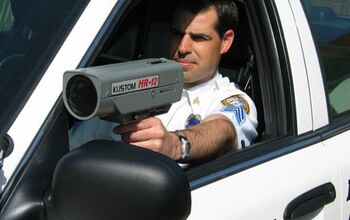The Insider's Guide to Speed Enforcement Pt. 2: Radar Detectors
On January 2, 1974, President Richard M. Nixon signed the Emergency Highway Energy Conservation Act. A provision of the Act imposed a new, national, 55 mph maximum speed limit. Overnight, the United States had a massive speeding “problem.” Within weeks, the feds gave huge amounts of money to police forces around the country to purchase radar guns. The speeding ticket, always a reliable cash cow for local governments, became a cash herd.
In response, the Fuzzbuster. The first commercial radar detector was a simple receiving unit. It picked up the high power continuous transmission of the early X-band police radar guns and sounded an alarm. Depending on the speed of the Fuzzbuster-equipped motorist, he or she had at least a half to a quarter mile before the signal was strong enough to bounce back to the police and provide a reading.
Escort tendered the next major advance. The old school black box Escort was a quantum leap in quality: the first superhetrodyne radar receiver commonly available. The Escort’s X-band detection distance was twice that of the Fuzzbuster. Equally important, the Escort also picked-up K-Band radar gun signals, emitted by the cutting edge revenue collection device of the early 80’s.
Once the police side switched to “instant on” radar guns, the game changed again. Detectors were no longer looking for a strong beam (think a set of xenon headlights shining down a dark highway). They were now trying to detect a child’s flashlight being turned on and off at random, during the day. Since a radar detector is essentially nothing more or less than a scanner, it has to cover the entire band over and over, looking for those wisps of radar.
To find those tiny wisps of K-band emissions, a device needs some serious microprocessing horsepower. That kind of microwave technology isn't cheap. Radar detector buyers looking for something more than a dashtop ornament that provides a false sense of security must now go to the top of a manufacturer’s line for electronic satisfaction.
Still, many folks held onto their Fuzzbusters, classic black box Escorts and later grey metal Passports. While they’re still great for detecting police radar guns operating on the X and K-band radar signal, they’re blind to the latest Ka-band police technology. I still see these on dashboards in New York Courts every week, in a state where 95 percent of the police radar systems run on the Ka-band.
I’m often asked “why can’t I just buy a radar jammer?” There are two stumbling blocks: money and the Federal Communications Commission (FCC).
Any item which transmits a radio signal falls under the FCC’s purview. To properly jam police radar unit, a jammer needs to receive a signal, “read it” and fire back a signal strong enough to overwhelm the radar gun– or vary the returning signal’s frequency slightly to confuse the police radar gun’s computer. The military has some fantastic devices for fighter planes that do all this, at military price points.
Even assuming you could create a usable civilian unit, the FCC would frown upon this endeavor in a most emphatic way. If they caught wind of even a single unit, they’d send you a “Notice of Liability” reminding you (with a huge fine) that you’re not allowed to jam any licensed service. (That's why Cell Phone jammers can't be sold in the US.) So back to detectors…
None of today’s radar detector can warn you of an “instant-on” police radar signal if you’re the first one through the trap. A detector is a radio receiver, no more, no less. Ka-band frequencies are tricky to detect. The frequencies used by many police radar guns for Ka-band are on the exact same frequency that some radar detectors transmit.
In traffic, surrounded by other cars, radar detectors are prone to a “Ka-false,” triggered by another radar detector. To keep users sane, detector makers will “notch out” that specific frequency– which is why police radar makers seek to transmit there. The expensive detectors have the computer power to figure out this riddle, which is why the $69 detector is more dangerous than nothing at all.
None of today’s most sophisticated radar detectors can detect all police radar guns all of the time in all situations, and do so with enough alacrity that the driver can check their speed before the police do. A safe driver will always drive only as fast as conditions allow, and use their cranium’s computing power (including memory) to avoid inadvertent speeding.
That said, a high-powered radar detector is a valuable tool for the serious driver with a lot of exposure time. It’s a little extra insurance, but, again, it’s not a free pass. Buy the best detector you can afford, but don’t change your driving style based on the box.
[Casey W. Raskob, Esq. is a NY-based lawyer who runs speedlaw.net]
More by Casey W. Raskob
Latest Car Reviews
Read moreLatest Product Reviews
Read moreRecent Comments
- MaintenanceCosts Nobody here seems to acknowledge that there are multiple use cases for cars.Some people spend all their time driving all over the country and need every mile and minute of time savings. ICE cars are better for them right now.Some people only drive locally and fly when they travel. For them, there's probably a range number that works, and they don't really need more. For the uses for which we use our EV, that would be around 150 miles. The other thing about a low range requirement is it can make 120V charging viable. If you don't drive more than an average of about 40 miles/day, you can probably get enough electrons through a wall outlet. We spent over two years charging our Bolt only through 120V, while our house was getting rebuilt, and never had an issue.Those are extremes. There are all sorts of use cases in between, which probably represent the majority of drivers. For some users, what's needed is more range. But I think for most users, what's needed is better charging. Retrofit apartment garages like Tim's with 240V outlets at every spot. Install more L3 chargers in supermarket parking lots and alongside gas stations. Make chargers that work like Tesla Superchargers as ubiquitous as gas stations, and EV charging will not be an issue for most users.
- MaintenanceCosts I don't have an opinion on whether any one plant unionizing is the right answer, but the employees sure need to have the right to organize. Unions or the credible threat of unionization are the only thing, history has proven, that can keep employers honest. Without it, we've seen over and over, the employers have complete power over the workers and feel free to exploit the workers however they see fit. (And don't tell me "oh, the workers can just leave" - in an oligopolistic industry, working conditions quickly converge, and there's not another employer right around the corner.)
- Kjhkjlhkjhkljh kljhjkhjklhkjh [h3]Wake me up when it is a 1989 635Csi with a M88/3[/h3]
- BrandX "I can charge using the 240V outlets, sure, but it’s slow."No it's not. That's what all home chargers use - 240V.
- Jalop1991 does the odometer represent itself in an analog fashion? Will the numbers roll slowly and stop wherever, or do they just blink to the next number like any old boring modern car?































Comments
Join the conversation
Laser is very hard to hit with a radar detector, if you are worried about laser try the laser pro park which will jam the laser signal, I own it myself pretty neat device but expensive, it will pay for itself eventually though.
I have ran a V1 in many states, awesome detector by the way, and have been able to get out of some tickets even still. The only situations they can get me in is if they have their radar turned down real low or off, and then turn it up when they see me coming. This is rare and 19 out of 20 times I have them a mile in advance. It has been my experience that it is always best to fight a ticket even if you were totally guilty. Pay the fine immediately same day. Even if you go into the court and ask for a plea bargain based on the fact that you will promise to slow down when going through that particular state or community and could they please accept the fine and forgive the points. In every moving violation I have ever had, this argument has worked to some degree. Go in dressed nice and be very mannerly, as in Good afternoon and yes sir or ma'am or your honor. Most judges are WAY WAY nicer than cops and certainly more understanding. Good luck. If you would like to ask me for advice you can email papagronk@yahoo.com. Happy trails.